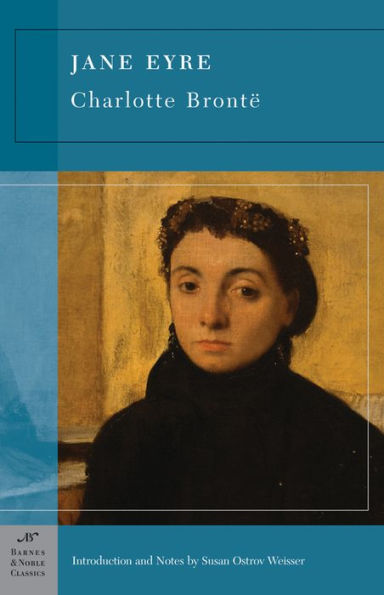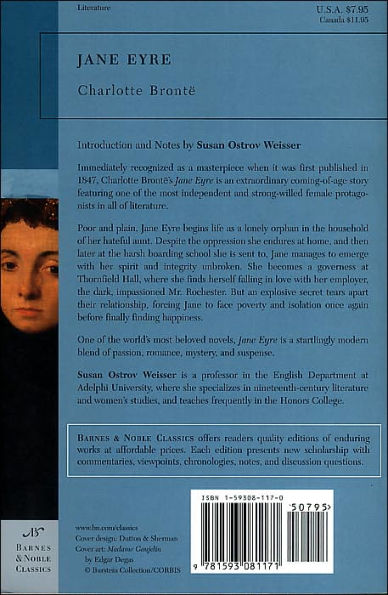- New introductions commissioned from today's top writers and scholars
- Biographies of the authors
- Chronologies of contemporary historical, biographical, and cultural events
- Footnotes and endnotes
- Selective discussions of imitations, parodies, poems, books, plays, paintings, operas, statuary, and films inspired by the work
- Comments by other famous authors
- Study questions to challenge the reader's viewpoints and expectations
- Bibliographies for further reading
- Indices & Glossaries, when appropriate
Immediately recognized as a masterpiece when it was first published in 1847, Charlotte Brontë’s Jane Eyre is an extraordinary coming-of-age story featuring one of the most independent and strong-willed female protagonists in all of literature. Poor and plain, Jane Eyre begins life as a lonely orphan in the household of her hateful aunt. Despite the oppression she endures at home, and the later torture of boarding school, Jane manages to emerge with her spirit and integrity unbroken. She becomes a governess at Thornfield Hall, where she finds herself falling in love with her employer—the dark, impassioned Mr. Rochester. But an explosive secret tears apart their relationship, forcing Jane to face poverty and isolation once again.
One of the world’s most beloved novels, Jane Eyre is a startlingly modern blend of passion, romance, mystery, and suspense.
Susan Ostrov Weisser is a Professor of English at Adelphi University, where she specializes in nineteenth-century literature and women’s studies. Her research centers on women and romantic love in nineteenth-century literature, as well as on contemporary popular culture. Weisser also wrote the introduction to the Barnes & Noble Classics edition of Persuasion.
- New introductions commissioned from today's top writers and scholars
- Biographies of the authors
- Chronologies of contemporary historical, biographical, and cultural events
- Footnotes and endnotes
- Selective discussions of imitations, parodies, poems, books, plays, paintings, operas, statuary, and films inspired by the work
- Comments by other famous authors
- Study questions to challenge the reader's viewpoints and expectations
- Bibliographies for further reading
- Indices & Glossaries, when appropriate
Immediately recognized as a masterpiece when it was first published in 1847, Charlotte Brontë’s Jane Eyre is an extraordinary coming-of-age story featuring one of the most independent and strong-willed female protagonists in all of literature. Poor and plain, Jane Eyre begins life as a lonely orphan in the household of her hateful aunt. Despite the oppression she endures at home, and the later torture of boarding school, Jane manages to emerge with her spirit and integrity unbroken. She becomes a governess at Thornfield Hall, where she finds herself falling in love with her employer—the dark, impassioned Mr. Rochester. But an explosive secret tears apart their relationship, forcing Jane to face poverty and isolation once again.
One of the world’s most beloved novels, Jane Eyre is a startlingly modern blend of passion, romance, mystery, and suspense.
Susan Ostrov Weisser is a Professor of English at Adelphi University, where she specializes in nineteenth-century literature and women’s studies. Her research centers on women and romantic love in nineteenth-century literature, as well as on contemporary popular culture. Weisser also wrote the introduction to the Barnes & Noble Classics edition of Persuasion.

Jane Eyre (Barnes & Noble Classics Series)
592
Jane Eyre (Barnes & Noble Classics Series)
592Related collections and offers

Product Details
| ISBN-13: | 9781593081171 |
|---|---|
| Publisher: | Barnes & Noble |
| Publication date: | 01/30/2005 |
| Series: | Barnes & Noble Classics Series |
| Pages: | 592 |
| Sales rank: | 101,172 |
| Product dimensions: | 5.18(w) x 8.00(h) x 1.48(d) |
About the Author

Customer Reviews
Explore More Items
At first glance, Three Lives seems to be three straightforward portraits of women living in the early twentieth century. “The Good Anna” describes an exacting German house servant;
‘Cheerfulness, it would appear, is a matter which depends fully as much on the state of things within as on the
The Professor was the first novel that Charlotte Brontë completed. Rejected by the publisher who took on the work of her sisters in 1846—Anne's Agnes Grey and Emily's Wuthering
'Dangerous as lucifer matches.'
That was how Arthur Nicholls, Charlotte Bronte's husband for the last nine months of her life, described her letters. Full of acute observations, pithy character
The Brontë family was a literary phenomenon unequalled before or since. Both Charlotte's Jane





